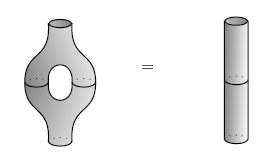Commutative Separable Algebras
Posted by John Baez
Now that I’m in Singapore, I’ll probably be thinking more about technology and the environment, and less about pure math. But I still want to keep working with Jim Dolan. It’s just too fun to quit.
For the last few years, we’ve been trying to learn algebraic geometry and number theory and recast certain portions of these subjects in terms more friendly to (-)category theorists. Not by adding fancy new layers on top of the existing work: rather, by making the basics even simpler.
This project is slowly picking up speed. But I don’t really want to talk about it now. It’s not ready for prime time yet. I mention it mainly to explain why I’m asking an elementary — I hope! — question about commutative separable algebras.
A separable algebra over some field is an (associative unital) algebra that’s not only semisimple, but remains semisimple as we extend the field to any larger field.
More precisely, an algebra over a field is separable iff for every extension of , the algebra is semisimple. And of course a finite-dimensional algebra — I’m only interested in finite-dimensional things, today — is semisimple iff it’s a product of simple algebras, meaning algebras that have no nontrivial ideals.
Q: What are some easy examples of commutative semisimple algebras that are not separable?
They seem a bit hard to come by, since I hear that if is a perfect field, all semisimple algebras over are separable. A field is perfect if every extension of is separable, regarded as an algebra over . But more importantly, for me, perfect fields include most of the fields I really care about! For example: fields of characteristic zero, finite fields, algebraically closed fields, and fields algebraic over a perfect field.
Am I making some sort of mistake, or is it really true that over finite fields or algebraic number fields, all semisimple algebras are separable? If so, I can stop worrying about the difference — at least for what we’re doing now. But still, I’d like to know the simplest examples where the difference kicks in… especially in the commutative case.
(Apparently there is a theorem of Eilenberg and Nakayama (maybe in here saying that a separable algebra can be given the structure of a symmetric Frobenius algebra. This is just the beginning of a network of interesting relations between separable algebras and Frobenius algebras, some of which are sketched here. But today I am more interested in how separable algebras show up in algebraic geometry!)


Re: Commutative Separable Algebras
Take an inseparable field extension of degree with characteristic . I claim that as a -algebra is not separable, that is that the base extension is not semisimple. Since it’s commutative it’s enough to just demonstrate a nilpotent element. So take an element of which is not in , and look at , a simple calculation shows that raising this element to the gives zero but the element itself is not zero. (This argument is taken from an article of Kuperberg’s but presumably is well-known.)
So your favorite example of an inseparable field extension from Galois theory is also an example here (the usual one is adjoing a th root of to ).